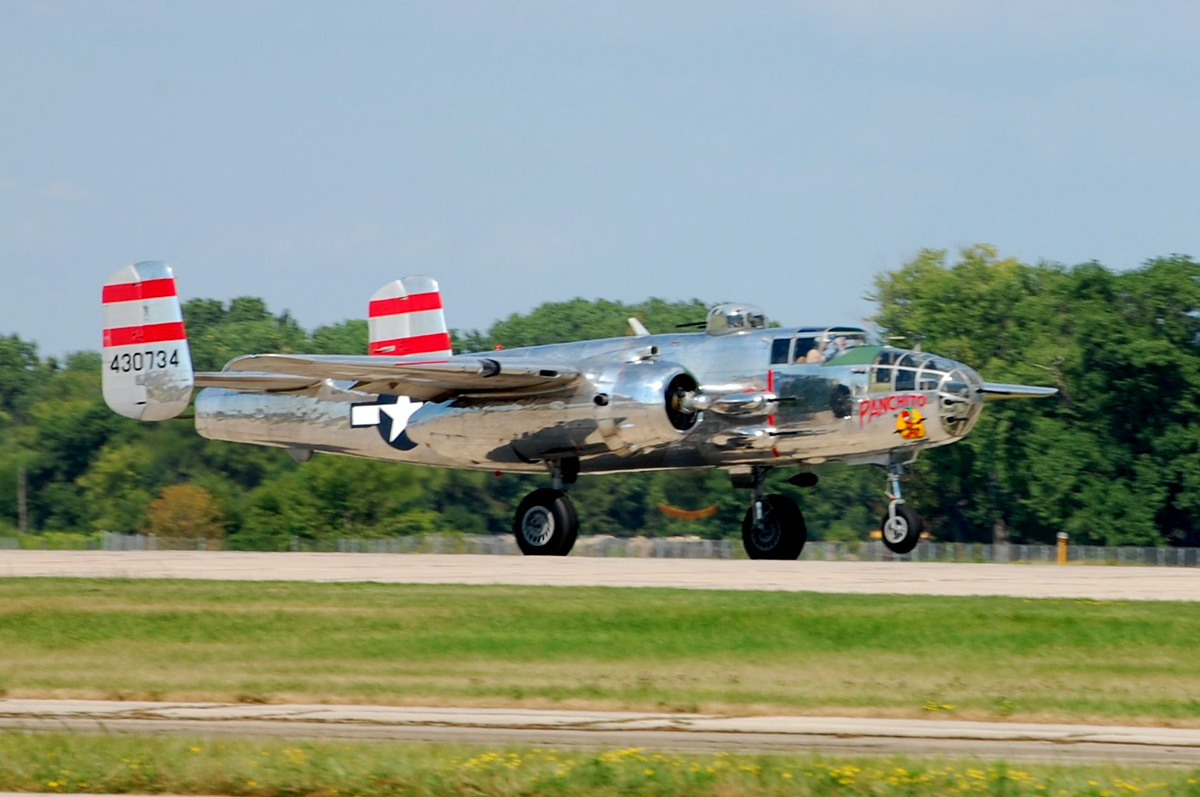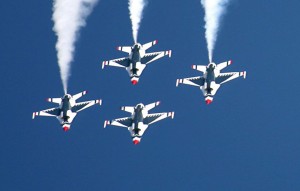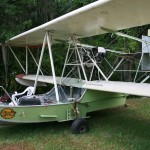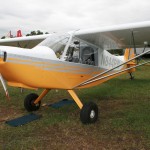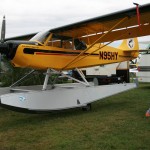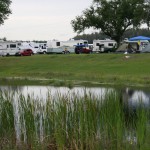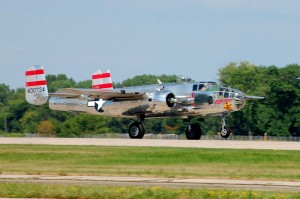
The CAF owns two Mitchell B-25 bombers. The name and nose art of Panchito was inspired by the Mexican rooster from the 1945 Disney animated musical, “The Three Cabarellos.”
By Henry M. Holden
For 34 years, the City of Lakeland, Fla., and Lakeland Linder Regional Airport (LAL) have hosted the Experimental Aircraft Association’s Sun ‘n Fun Fly-In. This year, between April 8 and 13, 153,000 people attended the opening of the 2008 air show season, with nearly 4,500 aircraft flying in for the show.
“Early attendance estimates and aircraft show numbers are tracking about four percent behind 2007,” said John Burton, president of the fly-in. “This year’s Sun ‘n Fun Fly-In overcame a slow start. We had a number of challenges, beginning with four inches of rain on Sunday before the fly-in. That certainly made things difficult, for both aircraft parking and our parking lots. But we finished strong, especially on Saturday, with the Thunderbirds’ performance.”
The rest of the week saw mostly sunny conditions, leading to an increasing number of aircraft arriving as the week continued. Burton credited the volunteers with helping get those parking areas suitable for aircraft and vehicles.
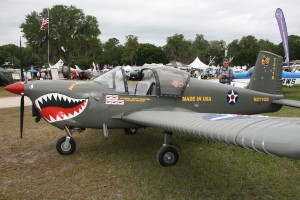
IndUS Aviation Inc. introduced the first diesel-powered light-sport aircraft, the Thorpedo DP. The WAM 120, a 120-hp three-cylinder, two-stroke, liquid-cooled turbocharged engine, powers the aircraft.
“The efforts expended by our volunteers were incredible,” he said. “They responded to every challenge we gave them.”
Closing day had some wet weather, but the air show went on as scheduled.
LSA Mall is born
Light-sport aircraft have quickly become center-stage attractions. LSA manufacturers and distributors were out in force to show off their high-wing and low-wing aircraft designs. As they entered the grounds, visitors couldn’t ignore the 20 LSAs; the new LSA Mall was close to the main entrance, perhaps signifying the heightened level of popularity.
“Last year, we had a welcome station and a handful of LSAs in an exhibit area,” said Dan Johnson, chairman of the Light Aircraft Manufacturers Association. “We had such a positive response that we felt we needed to expand. We noticed a grassy area right by the main gate where about 90 percent of the attendees walk through, yet it wasn’t getting much use. Now it is.”
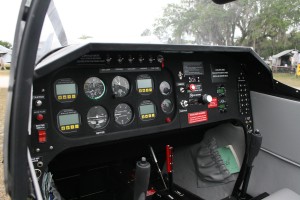
The cockpit of the Thorpedo Diesel is clean, with basic instruments. The company expects to have it ready for sale by EAA AirVenture Oshkosh 2008.
About half a dozen new LSAs showed up for the first time, including Paradise Aircraft’s P-I. This Brazilian design features a strutted high wing, tricycle gear and mostly metal construction. On first glance, it has a characteristic Cessna 150 look. The LSA features a welded steel tube structure from the firewall to the tail. Its Rotax 912 ULS engine delivers 100 hp through a three-bladed propeller, giving it a cruising speed of 104 kts while burning 5.3 gph. Inside, the two seats ride close to the floor, allowing plenty of headroom. Control yokes recessed into the panel provide adequate legroom. The aircraft on display had round gauges, but the company will install any avionics a customer requests.
Alan Klapmeier, CEO of Cirrus Design Corp., presented its prototype LSA. At EAA AirVenture Oshkosh 2007, Cirrus announced it had collaborated with FK GmbH of Germany to take that company’s FK14 Polaris and “Cirrusize” it to conform to American LSA standards. Since then, Klapmeier, who founded Cirrus with his brother, Dale, said the LSA, known as the SRS, was redesigned to take advantage of the U.S. light-sport rules.
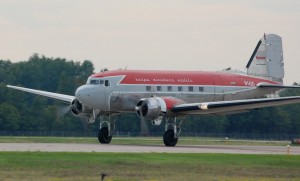
Dan Gryder, who provides DC-3 flights and flight training, owns this DC-3. At Sun ‘n Fun, he offered a ride to the winner of an essay contest on why someone wanted to fly a 70-year-old, twin-engine airliner.
“The LSA is powered by a Rotax engine, which is very quiet,” Klapmeier said. “It uses auto fuel, and that’s critical in a trainer that’s flying over the same houses repeatedly; we have to be friendly neighbors. It’ll also help keep costs down so that kids can afford to get into aviation.”
The gross weight will be close to the 1,320-pound limit. Klapmeier added that the new U.S.-built SRS would have a glass panel. He hopes the SRS will prove popular as a trainer, to entice new pilots between the ages of 18 and 25.
The Cessna Sport, Cessna’s proof-of-concept LSA model, unveiled at EAA AirVenture Oshkosh in 2006, and the flying SkyCatcher model, introduced in 2007, have been attracting attention. Cessna announced that the second SkyCatcher is now nearing completion and will soon join the flight-test program. The airplane, designated as the production prototype, will be equipped with a full interior in time to fly to AirVenture 2008 this summer. The airplane sells for $111,500.
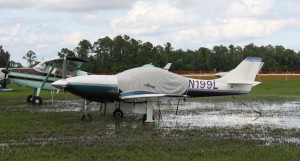
The Lakeland area received up to four inches of rain before the start of the event. Early visitors called the event “Rain ’n Pain” and “Mud ’n Scud.” As sunny weather returned and the ground began to dry, hundreds more airplanes arrived through the week.
On Saturday, the world’s first diesel-powered LSA, the Thorpedo DP, made its U.S. debut at a packed news conference. A recently developed WAM 120 turbocharged three-cylinder engine that burns three gallons of Jet A per hour powers the aircraft. The two-cycle, inverted cylinder engine puts out 120 hp and will pull the low-wing aircraft along at about 100 kts.
“This is a proof-of-concept aircraft,” explained Dr. Ram Pattisapu, president of IndUS Aviation Inc., manufacturer of the diesel LSA. “The engine’s been flying in a Thorp for almost four years now. It’s quiet and has unbelievable climb performance, even at altitude. At 14,000 feet, it’s climbing at 500 fpm.”
The engine is undergoing light-sport certification. Initial time between overhauls is 1,000 hours but IndUS expects TBO to go to 3,000 hours.
The Thorpedo DP was dressed in an olive-drab paint, with an Army Air Corps insignia with the meatball design. The decals on the plane honor the pilots of World War II, according to Pattisapu. The faux bullet holes give the aircraft a fanciful look.

With near-bog conditions, Sun ‘n Fun attendees used ingenuity and plywood planking to solve aircraft mobility problems.
More than 30 aerobatic performers and teams took to the skies to thrill the thousands of spectators. Among them were Patty Wagstaff, the AeroShell Aerobatic Team, Julie Clark, Matt Chapman and Steve Oliver. Bob Wagner and Larry King preformed all six days. The warbirds flyover also thrilled and impressed the crowds.
Military presence
Opening day saw a B-1 and a B-2 flyover at 2:45 p.m. This flyover continued each day, preceding the air show. However, neither airplane landed.
The AV-8B Harrier, which can take off and land like a helicopter, arrived during the middle of the air show on Friday. This was the first time a Harrier has been at Sun ‘n Fun, and it remained on static display through the end of the fly-in.
Two V-22 Osprey (tilt-rotor) aircraft arrived on Friday and remained on display through Sunday. The V-22 takes off and lands like a helicopter, but once airborne, the pilot can rotate the engines to convert the aircraft to a twin-turbine airplane.
A group of air-to-air refuelers arrived on Thursday, among them a KC-707, KC-767 and a KC-10, the largest aircraft ever to appear at Sun ‘n Fun. They remained on static display.
Thunderbirds
When the Thunderbirds performed on the weekend, the audience witnessed the definition of teamwork in action.
“While its mission is to thrill the audience, the Thunderbirds encourage not only children, but also all who watch them perform, to just go for whatever you’re passionate about,” said Capt. Elizabeth Kreft, public information officer for the U.S. Air Force’s military jet team.

Cirrus Corp.’s SRS light-sport aircraft attracted great interest. Cirrus redesigned the SRS to take advantage of the U.S. light-sport rules.
“We don’t try to recruit everybody we meet,” said Kreft. “We realize the Air Force isn’t for everybody. But at the heart of it, if people pursue their passions, they’ll become better citizens and that will eventually make the country a better place.”
Kreft noted that during talks with young people, the Thunderbirds always encourage children to have a dream, pursue it and “not let anyone tell you no.”
Commemorative Air Force
The CAF has more than 170 former military airplanes representing 60 types—that’s more aircraft than the air forces of some countries. This year the CAF increased its presence at Sun ‘n Fun with a mass arrival of priceless aircraft that represented a legacy period in aviation history. Among 13 CAF aircraft at the show were Red Nose, a P-51D Mustang available for public flights; two B-25J Mitchell bombers, Yellow Rose and Panchito; an LT-6 Mosquito; a Douglas SBD-5 Dauntless; a PT-26 Cornell; and a Curtiss SB2C Helldiver.
Forums galore

The Paradise P-I, a Brazilian-designed LSA made mostly of metal construction, has a strutted high wing and tricycle gear.
Anyone who dreams about owning an airplane, building one or flying to faraway places had a chance to whet that appetite at this year’s forums, free with general admission. The air show offered nearly 300 forums on these topics and others. The International Council of Air Shows also offered a wide selection of forums about aerobatics.
Splash-In moves to Fantasy of Flight
This year the popular “splash-in” portion of the annual fly-in moved from Lake Parker in Lakeland, Fla., to nearby Lake Agnes in Polk City—adjacent to the aviation attraction, Fantasy of Flight. Burton said the decision was made because the location would have a positive impact on safety, logistics and participation.
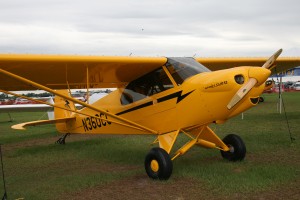
This 2008 CubCrafters Inc. Sport Cub S2 has an empty weight of 865 pounds on wheels, and weighs in at 980 pounds on floats. The latest performance-improving innovation on the Sport Cub S2 is an optional Sensenich ground-adjustable, carbon fiber prop.
“At the same time, it offers an opportunity for participants and their guests to enjoy the short hop to Fantasy of Flight and to enjoy the attraction’s incredible facilities,” he said.
Designed especially for amphibians and seaplanes, the splash-in has become an increasingly popular and integral part of the Sun ‘n Fun week. The event includes competitions among seaplane pilots as well as flybys to give pilots a chance to show off their prized possessions.
Next year’s Sun ‘n Fun will take place April 21-26. For more information, visit [http://www.sun-n-fun.org].
- The Cessna Aircraft Company’s 350 is a low-wing, high-performance, turbocharged piston aircraft. Formerly made by Columbia, it has an all-composite airframe, Garmin G1000 avionics, GFC700 flight control system and a Teledyne Continental TSIO-550-C engine.
- Owned by the Sun ‘n Fun Aviation Foundation, this Henry C. Palmer Sunshine Clipper was built in 1987.
- The Rans Inc. S-7S Courier is the modern day Cub. Its design originated from the need to train single-seat Coyote pilots. The cockpit has the same setup with throttle left, stick in the middle. Rans named the aircraft in honor of the Helio Courier.
- The A-22 Valor, built by Float Planes and Amphibs, is a rugged go-anywhere aircraft. Short takeoff and landing performance is excellent. Its base price starts at $79,999.
- Aviat Aircraft Inc. had an impressive display, drawing crowds to see the company’s sport and utility aircraft.
- Formerly available in the U.S. with only a tricycle gear configuration, the EuroFox is now available as a taildragger.
- This Airmax SeaMax M22 utilizes a Rotax 912ULS engine. This 2007 model is a recent entry into the LSA amphibian type.
- While Sun ’n Fun campers got soaked early in the week, a pond and an airport runway offered thousands of aviation enthusiasts beautiful campsites.
- Nearly 500 exhibitors agreed it was a successful show, although many acknowledged a slow start due to the weather.
- This Howard DGA-15P was one of 250 sold by the Howard Aircraft Co. to the U.S. Navy. It was built in 1944 and shipped to Hawaii for the Navy in March that year; it was decommissioned in June 1946. In February 1947, it was converted to civilian use.











